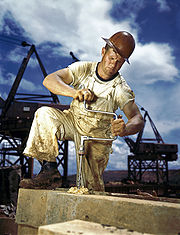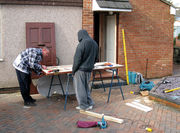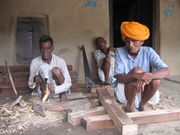Carpentry


A carpenter (builder) is a skilled craftsperson who performs carpentry, see also Joiner. Carpenters work with wood to construct, install and maintain buildings, furniture, and other objects. The work may involve manual labor and work outdoors.[1]
Carpentry skill is gained through experience and study. Outside of unions, there are no formal training requirements (in the U.S.) and the trade can be easy to enter. In other countries, such as Germany, Japan and Canada there are strict standards.
The word "carpenter" is the English rendering of the Old French word carpentier (become charpentier) which is derived from the Latin carpentrius [artifex], "(maker) of a carriage.[2] The Middle English and Scots word (in the sense of "builder") was wright (from the Old English wryhta), which could be used in compound forms such as wheelwright or boatwright.[3]
In British slang, a carpenter is sometimes referred to as a "chippie". In Australia, they are often called "tradies". One of the German words for carpenter is "Zimmermann" (room-maker, literally room-man), and hence is the source for the surname in German and English-speaking countries. Other woodworking names/professions, that also occur as a surname, are Tischler and Schreiner.
Carpentry in the United States is almost always done by men. With 98.5% of carpenters being male, it was the fourth most male-dominated occupation in the country in 1999.[4]
Contents |
Types and occupations
A finish carpenter (South America) also called a joiner (traditional name now obsolete in North America) is one who does finish carpentry; that is, cabinetry, furniture making, fine woodworking, model building, instrument making, parquetry, joinery, or other carpentry where exact joints and minimal margins of error are important. Some large-scale construction may be of an exactitude and artistry that it is classed as finish carpentry.

Ethnographic Museum of Western Liguria, Cervo, Italy
A trim carpenter specializes in molding and trim, such as door and window casings, mantels, baseboard, and other types of ornamental work. Cabinet installers may also be referred to as trim carpenters.
A cabinetmaker is a carpenter who does fine and detailed work, specializing in the making of cabinets made from wood, wardrobes, dressers, storage chests, and other furniture designed for storage.
A ship's carpenter specializes in shipbuilding, maintenance, and repair techniques (see also shipwright) and carpentry specific to nautical needs; usually the term refers to a carpenter who has a post on a specific ship. Steel warships as well as wooden ones need ship's carpenters, especially for making emergency repairs in the case of battle or storm damage.
A scenic carpenter in film-making, TV, and the theater builds and dismantles temporary scenery and sets.
A framer is a carpenter that builds the skeletal structure or framework of buildings. Techniques include platform framing, balloon framing, or timber framing (which may be post-and-beam or mortise-and-tenon framing).

A luthier is someone who makes or repairs stringed instruments. The word luthier comes from the French word for lute, "luth".
A formwork carpenter creates the shuttering and falsework used in concrete construction.
In Japan, Miya-daiku (Temple carpenter) performs the works of both architect and builder of shrine and temple.
Green carpentry is the specialization in the use of environmentally friendly,energy-efficient and sustainable sources of building materials to use in construction projects.[5]
Training

Tradesmen in countries such as Germany are required to fulfil a formal apprenticeship (usually three years) to work as a professional carpenter. Upon graduation from the apprenticeship, he or she is known as a journeyman carpenter. Up through the 19th and even the early 20th century, the journeyman traveled to another region of the country to learn the building styles and techniques of that area before (usually) returning home. In modern times, journeymen are not required to travel, and the term refers more to a level of proficiency and skill. Union carpenters in the United States - United Brotherhood of Carpenters and Joiners of America - are required to pass a skills test to be granted official journeyman status, but uncertified professional carpenters may be known as journeymen based on their skill level, years of experience, or simply because they support themselves in the trade, and not due to certification or formal woodworking education.
After working as a journeyman for a period, a carpenter may go to study or test as a master carpenter. In some countries, such as Germany or Japan, this is an arduous and expensive process, requiring extensive knowledge (including economic and legal knowledge) and skill to achieve master certification; these countries generally require master status for anyone employing and teaching apprentices in the craft. In others, it can be a loosely used term to describe a skilled carpenter. In Canada carpentry is a Red Seal trade not requiring a formal apprenticeship and an inter-provincial exam. While each province sets its own standards for exactly how long the apprenticeship takes the average is about 4 years of both on the job instruction and college based training or on the job apprenticeships.
In the modern British construction industry, carpenters are trained through apprenticeship schemes where GCSEs in Mathematics, English and Technology help, but are not essential. This is deemed as the preferred route as young people can earn and gain field experience whilst training towards a nationally recognized qualification.
Fully trained carpenters and joiners will often move into related trades such as Shop fitting, frameworking, bench joinery, maintenance and system installation.
Notable carpenters
|
|
See also
- Building construction
- Guild
- Carpenter (theatre)
- Atlanta Community ToolBank
References
- ↑ Byron W. Maguire (1988). Carpentry in Commercial Construction. Craftsman Book Company. ISBN 0-934041-33-4.
- ↑ The American heritage dictionary of the English language - Etymology of the word "carpenter"
- ↑ The American Heritage Dictionary of the English Language: Fourth Edition. 2000.
- ↑ "Evidence From Census 2000 About Earnings by Detailed Occupation for Men and Women. Census 2000 Special Reports, May 2004." (PDF). http://www.census.gov/prod/2004pubs/censr-15.pdf. Retrieved 2006-09-02.
- ↑ "Defining Green-Collar Jobs". http://www.uwex.edu/CES/cced/communities/documents/GreenCollar.pdf. "There is no consensus on how to define green-collar jobs. A very broad interpretation of green jobs would include all existing and new jobs that contribute to environmental quality through improved efficiencies, better resource management, and other technologies that successfully address the environmental challenges facing society. Probably the most concise, general definition is “well-paid, career track jobs that contribute directly to preserving or enhancing environmental quality” (Apollo Alliance 2008, 3). This definition suggests that green-collar jobs directly contribute to improving environmental quality, but would not include low-wage jobs that provide little mobility. Most discussion of green-collar jobs does not refer to positions that require a college degree, but they typically do involve training beyond high school. Many of the positions are similar to skilled, blue-collar jobs, such as electricians, welders, carpenters, etc."
External links
- the Institute of Carpenters
- Carpenters - from the BLS Occupational Outlook Handbook